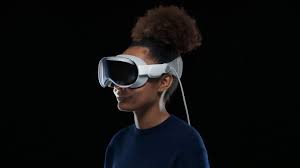Apple’s bid to bring spatial computing into everyone’s daily life may be out of step with today’s technology.
February 2024 marked the release of the Apple Vision Pro, Apple’s push for virtual reality to be a part of everyone’s daily life. However, professionals remain skeptical that this will be the product to crack the mainstream.
Any system which brings users out of the physical world is called virtual reality. Usually accomplished through a headset equipped, screens embedded inside display any world one can imagine. A version of this technology is Augmented Reality, AR, which adds overlays on top of the real world instead of transporting you to a new one.
The Apple Vision Pro is an example of an AR device. The headset places virtual displays wherever the user wants, using eye tracking and hand gestures as inputs. Apple calls this “spatial computing” and aims to create a new flavor of computer that isn’t tethered to any single desk or monitor.
Professor Kevin Ponto, who now teaches a virtual reality course at UW-Madison, previously helped implement virtual reality for homicide investigations, shipwreck reconstruction, and tactical headsets for SWAT and firefighter teams. According to Ponto, the Apple Vision Pro excelled in a couple areas: “In terms of its ergonomics, it’s a very comfortable headset. The cameras are definitely better, and the screens are better than the Quest Three.”
Most importantly, he sees the Apple Vision Pro setting a few new features as standard in the virtual reality headset space. “The idea of having a headset being only virtual reality is going to go away. All VR headsets are now going to be AR based, because it is a much better experience,” Ponto explains.
Additionally, Apple solved a long running issue in the AR space. “When running an application with a lot of computation, the visuals would need to take a backseat and the tracking would lag,” Ponto describes. Apple solved this by adding a second processor in the headset to track the user’s environment, enabling a program to take up as much computing as it wants.

With Apple’s innovations, a future where ideas are seamlessly communicated feels possible, bringing virtual mock-ups into the real world in a way that can be seen and discussed by anyone with a headset. However, Ponto clarifies, “The vision is great. It’s just the technology, that’s where it feels like we are all hung up.”
The Apple Vision Pro is currently a clunky experience. It weighs nearly one and a half pounds and requires the user to clip an additional battery to their waist. Before becoming commonplace, the technology may need to shrink considerably – Ponto estimates that “once we are in the sunglasses form factor, there are so many applications which [the Vision Pro] could be used for.”
On top of this is the exorbitant price of the headset. Ten years ago, headsets cost 25 thousand dollars and were riddled with errors. The landscape has since changed considerably, and today’s flagship headsets, like the Meta Quest Three, retail for 500 dollars. That makes the Apple Vision Pro seven times more expensive at 3,500 dollars – a cost that’s hard to justify.
“The vision is great. It’s just the technology, that’s where it feels like we are all hung up.”
Kevin Ponto
Furthermore, there are roadblocks to developing software for this new headset. As Ponto explains, “you can’t get access to the cameras or depth sensors, for privacy reasons. Additionally, they are requiring a Unity Pro subscription that costs thousands of dollars a year just to develop apps for it.”
These errors are mixed with what Ponto calls “quirks,” like a buggy keyboard, Facetime with avatars, and bug-like eyes being displayed as the headset is in use.
These shortcomings remind us that this is a first-generation product. However, with that comes an open door for large strides in future versions. Apple accomplished some groundbreaking work with this headset, but if we want to see a world with true integration of AR into our daily lives, we must still look to the future.

